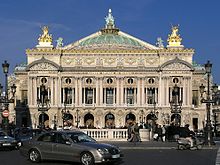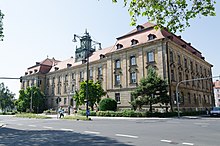Neo-baroque




Neo-Baroque (also: Neo- Baroque or Second Baroque ) is the designation of a style in architecture , sculpture and, with reservations, in music (correct musical style term: neoclassicism ). The term is also increasingly being applied to modern literature .
Neo-Baroque, a form of historicism , is assigned to the second half of the 19th century. It started around 1860, but spread mainly after 1880. Napoleon III. built the first large neo-baroque buildings in 1857 with the Tuileries and in 1860 with the Paris Opera . The Herrenchiemsee Palace was built in Bavaria and recreated the Hall of Mirrors at Versailles.
Neo-Baroque was particularly popular for theater buildings, as the Baroque brought all theatrical art forms to their peak. In the late phase of historicism, the previous orientation towards the Renaissance took a back seat and forms of the Baroque were used for a variety of building tasks, sometimes also for villas and other representative residential buildings.
In Austria , its use had a "patriotic" connotation , as it was linked to the cultural bloom and political expansion of the early 18th century. In its later phase it coexisted with Art Nouveau , which it partially influenced.
Buildings
Secular building
- Opéra Garnier in Paris , 1854–1874
- Baden-Baden Theater , 1860–1862
- Palace of Justice in Brussels , 1866–1879
- Linderhof Palace , 1874–1878
- State Opera in Budapest , 1875–1884
- Herrenchiemsee New Palace , 1878–1886
- Livingston horse stable in Frankfurt am Main , 1880
- Károlyi Palace in Budapest , 1881–1883
- Wenckheim Palace in Budapest , 1886–1889
- Theater am Schiffbauerdamm in Berlin , 1891–1892 (rebuilt in simplified form)
- State Theater in Salzburg , 1892–1893
- Burgtheater in Vienna , 1893–1894
- Hessian State Theater in Wiesbaden , 1893–1894
- uh General landscape in Szczecin , 1891–1895
- Comedy Theater (Vígszínház) in Budapest, 1886
- Hereditary Grand Ducal Palace (today Federal Court of Justice ) in Karlsruhe , 1891–1897
- Opera house in Graz , 1898–1899
- Former government building (today the main building of the European University Viadrina) in Frankfurt (Oder) , 1898–1906
- Villa Thyssen in Mülheim an der Ruhr , 1899–1900
- Bode Museum in Berlin, 1897–1904
- The Reichstag and former Reichsbank building in Stockholm , 1897–1905
- New Hofburg in Vienna, 1881–1914
- Opera house on Habsburgerring in Cologne , 1899–1902 (partly destroyed and later demolished)
- German theater in Hamburg , 1900
- Former main post office (today post gallery ) in Karlsruhe, 1900
- Former industrial school (now the German Toy Museum ) in Sonneberg , 1900–1901
- Loburg Castle , 1900–1902
- Adria Palace of the Adria Shipping Company in Budapest, 1903
- Saxon State Chancellery in Dresden, 1900–1904
- Stadttheater Fürth , 1901–1902
- Nuremberg main station , 1900–1906
- Palace of Justice in Schweinfurt , 1903–1905
- Leopold Hoesch Museum in Düren , 1905
- Büsing-Palais in Offenbach am Main , 1905
- former government building (today town hall) in Potsdam , 1902–1907
- State house in Wiesbaden, 1903–1907
- Festhalle in Frankfurt am Main, 1907
- Laeiszhalle in Hamburg, 1904–1908
- Oberpostdirektion in Augsburg , 1905–1908
- Palace of Justice in Munich , 1905
- District court Elberfeld (today Wuppertal ), 1906–1908
- Police station at Klingberg in Hamburg, 1906–1908
- Town hall in Kassel , 1904–1909 (simply rebuilt)
- Town hall in Bozen , 1907
- Charlottenburg Gate in Berlin, 1907–1908
- Ashton Memorial in Lancaster , 1907–1909
- Palatul Cantacuzino in Bucharest, 1909
- Bank for Thuringia in Meiningen , 1909–1910
- Higher Regional Court in Cologne, 1909–1911
- Villa Wolf in Zwickau, 1910–1911
- Observatory in Hamburg-Bergedorf , 1906–1912
- former Ministry of War in Vienna, 1909–1913
- Szechenyi Bath in Budapest, 1913
- Villa Borsig on the Reiherwerder island in Berlin-Reinickendorf , 1911–1913
- Herschelbad in Mannheim , 1912–1916
- Körnerpark in Berlin-Neukölln , 1912–1916
- Old town house in Bonn , 1922–1925
- Christiansborg Palace in Copenhagen , 1907–1928
Sacred building
- Ortakoy Mosque in Istanbul , 1853–1856
- Tower of the Dreikönigskirche in Dresden, 1854–1857
- Sint Nicolaaskerk in Amsterdam , 1884–1887
- St. Nikolaus in Siegenburg , 1892–1893
- Johanniskirche in Leipzig , 1894–1897 (destroyed in the war, blown up around 1963)
- St. Joseph in Munich , 1898–1902
- Tower of the Georgenkirche in Eisenach , 1899–1902
- Joseph's Church in Basel , 1900–1902
- Matthäuskirche in Hamburg, 1900–1902
- Old Synagogue in Potsdam, 1900–1903 (destroyed in 1938)
- Church of St. Fridolin in Mulhouse , 1901–1906
- St. Stephan Church in Kreuzlingen , 1903
- Niedergösgen Castle Church , 1903–1904
- Christ Church in Mannheim, 1907–1911
- St. Anton in Passau , 1908–1910
- Thomas Church in Wuppertal, 1909–1910
- St. Maurice Church in Freyming-Merlebach , 1911–1913
- St. Wolfgang in Haidhausen , 1915–1920
- Catholic parish church to the Holy Guardian Angels in Eichenau , 1926
sculpture
At the same time as in architecture, neo-baroque tendencies appear in sculpture. The Berlin sculptor Reinhold Begas and the Viennese Victor Tilgner are considered to be the main representatives of Neo-Baroque .
Examples:
- Mende fountain in Leipzig (1883)
- Neptune Fountain in Berlin (1886-1891)
- Siegesallee in Berlin (1895–1901)
- Mozart monument in Vienna's Burggarten (1896)
music
In music, the current of neoclassicism is sometimes incorrectly referred to as neo-baroque. Despite the difficult delimitation (the compositional direction that developed in the early 20th century took up both classical and late Baroque forms and stylistic devices ) the term neoclassicism has established itself in music history and in the authoritative professional music encyclopedias ( MGG old, MGG new, New Grove Dictionary ) .
Literature and film
Some literary trends and film styles of the 20th and 21st centuries have neo-baroque features. One speaks in particular of a Latin American neo-baroque. The Magic Realism , but also many works of postmodernism wearing neo-baroque features. Since everything has already been said, today images and texts can only be combined, varied, changed more and more quickly or quoted. The variety of forms and the citation would have reached an extent that was unimaginable a few years ago, postulates the Italian linguist and semioticist Omar Calabrese (1949–2012) and develops a theory of the poetics of repetition.
Web links
Individual evidence
- ↑ Nicolas Freund: Die hardest Faust in sueddeutsche.de, March 5, 2019.
- ↑ Omar Calabrese: Neo-Baroque: A Sign of the Times. Princeton UP 1992.







